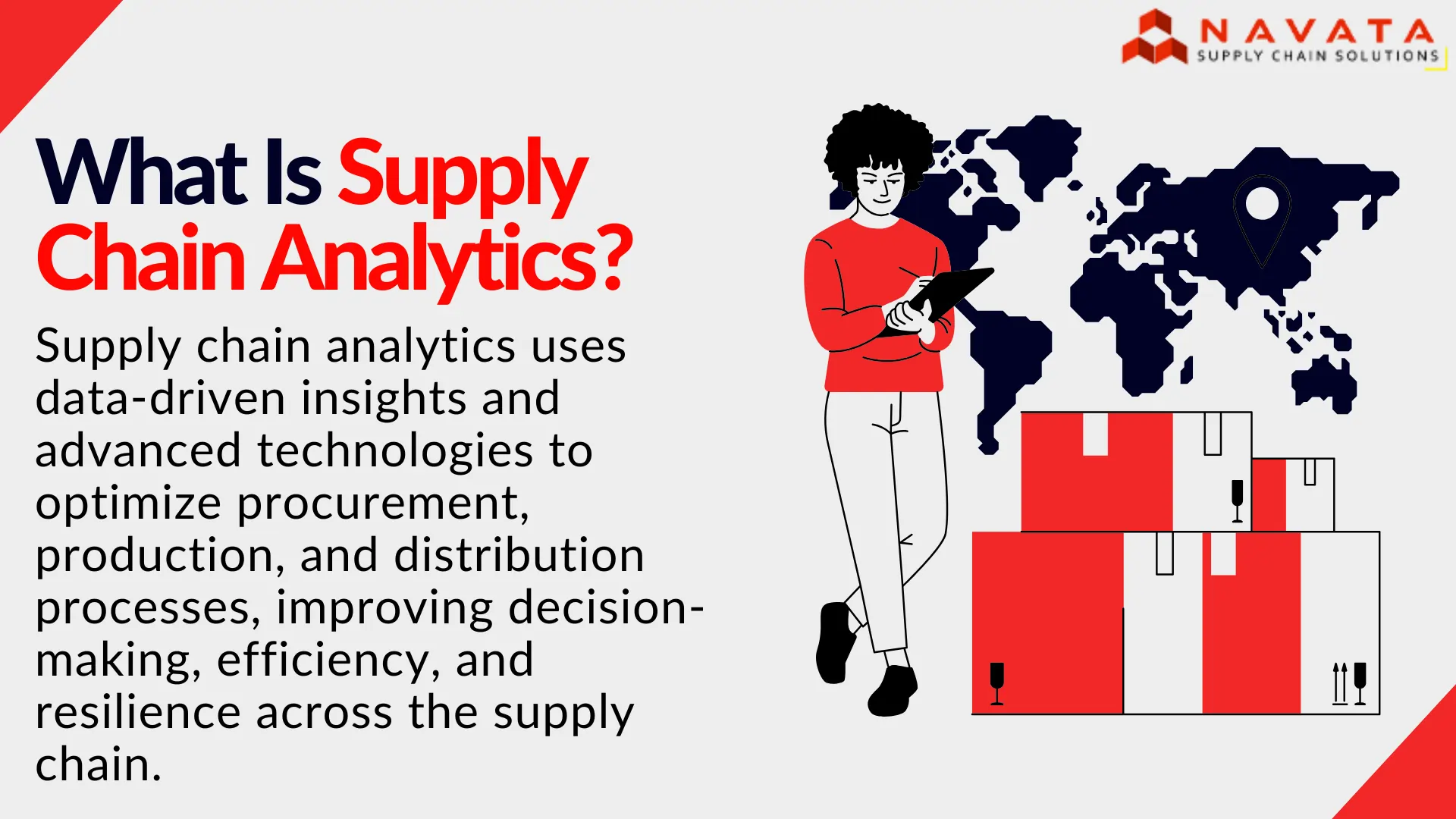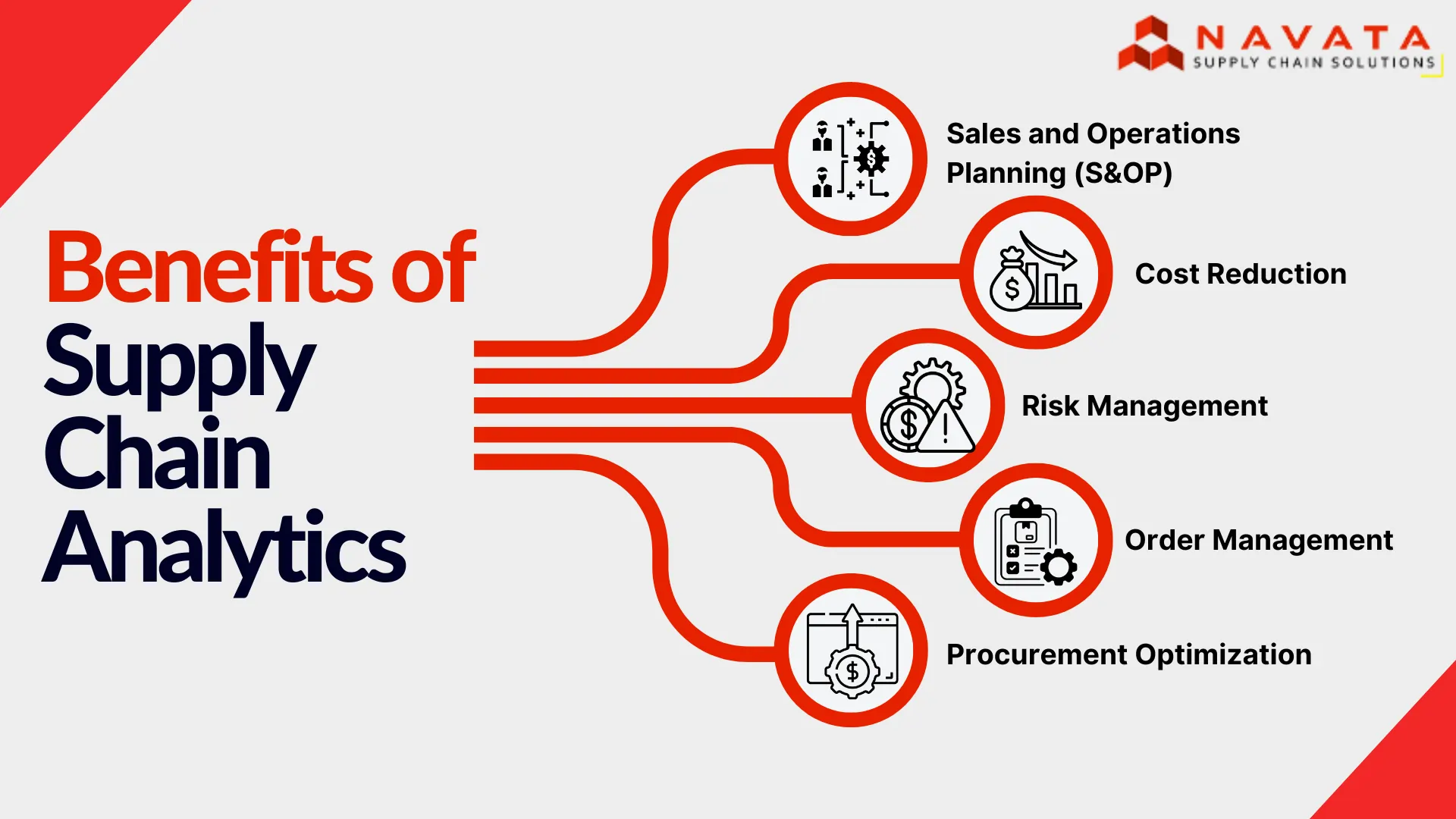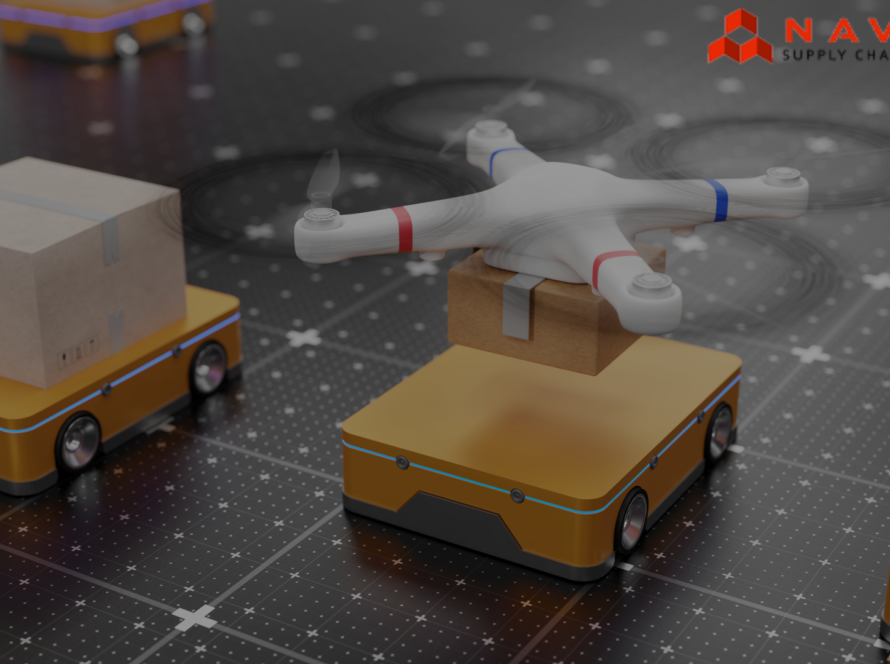What Is Supply Chain Analytics?
Supply chain analytics is defined as the activities and tools applied by companies to identify important insights regarding the large amount of data generated during procurement, manufacturing and logistics of products. Being a subdiscipline of SCM, supply chain analytics focuses on improving the decisions made and the efficiency of the supply chain. It translates data into solutions, strategies and tactics that fit into market changes, thus enabling organisations to optimize performance.

Evolution of Supply Chain Analytics
However, despite being still a relatively old concept, supply chain analytics has changed throughout the decades. Many methods of optimization have been implied and developed in the past, such as linear programming as a basis for modern mathematical modeling, which has been developed with the help of predictive modeling, machine learning, and better statistical methods. Advancements like cloud computing, complex event processing (CEP), and the Internet of Things (IoT) have made it possible to process real-time supply chain data making the supply chain more responsive.
These advancements enable organizations to better understand a number of important supply chain functions including ERP, warehouse, and transportation. Blockchain and 5G connectivity, for instance, provide more accuracy and faster ways of processing data to allow supply chain integration.
Objectives of Supply Chain Analytics
Supply chain analytics is used to enhance the predictive models and workflow of the supply chain. Using predictive analytics on POS systems, for example, companies can forecast demand, lower inventory expenses, and make timely deliveries. Another goal is the end-to-end visibility of the goods from procurement through production and distribution.
Such levels of transparency are useful in avoiding disruption and guaranteeing the supply chains to meet customer needs. Further, supply chain analytics contributes to sustainability by promoting efficiency and reducing waste so as to achieve corporate social responsibility.
Types of Supply Chain Analytics
Supply chain analytics is categorized into four primary types, each serving distinct yet interconnected purposes. By leveraging these analytics, organizations can analyze historical data, identify inefficiencies, forecast future trends, and make data-driven decisions. Below is an expanded overview of each type:
Descriptive Analytics
Descriptive analytics deals with the supply chain performance analysis using historical data. It gives an account to the question, “What happened?” by collecting and summarising data like previous inventory data, cost of transportation, and rate of order deliveries. For example, a company may analyze monthly inventory level changes in an attempt to identify cyclical trends in demand.
Thus, descriptive analytics creates the prerequisites for further analysis by providing a graphical executive summary in the form of a dashboard or an analytical report. It assists in finding trends, setting benchmarks, increasing the credibility of reporting, and creating a strong framework for decision-makers.
Diagnostic Analytics
Diagnostic analytics is a step up from reporting what has happened by providing the why behind problems or issues. It addresses the question, “Why did it happen?” by defining key sources of variances to planned performance levels. For example, if there is a delay in shipment, diagnostic analytics can identify causes ranging from port-related issues, supplier-related issues, or routing issues.
Such an analysis enables business entities to solve problems systematically and avoid their occurrence in the future. Thus, diagnostic analytics based on the identification of the cause of the problem is the key to improving organizational performance and reducing potential disturbances.
Predictive Analytics
Predictive analytics uses innovative methods like the use of big data, data mining, and statistics to predict future events and possibilities. It answers the question, “What is likely to happen?” by using quantitative data to make qualitative forecasts such as traffic peaks in demand, slow supply, or market shifts. For instance, a retailer might apply predictive analytics to the occurrence of a sales increase in winter clothing due to weather and previous sales trends.
This makes it possible for business firms to prepare in advance thus minimizing situations where they may have to order for goods they do not have stock or when they have a lot of stock in their stores. Predictive analytics is a way in which organizations can foresee difficulties, manage stock, and make sound decisions.
Prescriptive Analytics
Prescriptive analytics goes a step beyond other forms of analytics in that it also provides recommendations for the best action to take. It addresses the question, “What should one do?” by applying artificial intelligence, optimization heuristics, and simulation to recommend actions that would lead to a particular effect. For example, prescriptive analytics can help a manufacturer decide the right way of re-distributing inventories across warehouses so as to satisfy regional demand efficiently.
This approach not only offers prescriptive information but also offers information that can be used to make decisions in high-velocity and unpredictable settings. Prescriptive analytics is the process by which a business maximizes the use of resources, minimizes costs, and improves the efficiency by which it can address challenges and take advantage of opportunities.
Benefits of Supply Chain Analytics
Sales and Operations Planning (S&OP)
Supply chain analytics is particularly important in achieving supply-demand match through Sales and Operations Planning (S&OP). As a result of analytics, data from different sources including historical sales data, market trends, and production capability are consolidated to offer a single view of supply and demand. This aids organizations in how they forecast the inventory they will need to stock to fulfill the customers’ demand without having excess stock or inadequate stock.
For instance, a manufacturer can use the information to forecast when to produce more of a certain commodity, so that it is on the shelves when the demand is high, or not produce more of it to avoid being stuck with excess stock. This alignment also serves the strategic objectives by providing the logistic link while at the same time increasing customer satisfaction through an efficient supply chain.
Cost Reduction
Another advantage of supply chain analytics is the reduction of cost since the process points out areas of improvement in various processes, resources, and operations. For instance, when analyzing the production line, the tools can identify that some steps are not necessary or that transportation resources are not optimally used by the firms.
Also, it can compare the costs between the suppliers and the distribution channels, which in return identify cost savings. This way, practical recommendations allow for cutting inefficiency, achieving better terms of cooperation with suppliers, and optimizing resource distribution, which may lead to enormous cost-saving and high organizational performance.
Risk Management
Risk management in supply chain analytics is done by identifying probable disruptions to the chain and preparing the organization for them. Using information from weather predictions, global shifts, and supplier performance reports, companies can anticipate a threat before it occurs. For instance, analytics might estimate that there will be a delay due to the cyclone and then suggest that the shipments should be avoided in the affected regions.
This approach enables one to reduce the effects of disruption, maintain service, and fashion a robust supply chain. Analytics also helps in supply chain risk management in that it can also be used in creating a scenario analysis of the effects of various risk management strategies.
Order Management
Another important application of supply chain analytics is the efficient management of orders. In the case of real-time inventory, order history, and customer preferences, it becomes easier for a business to enhance the efficiency of its fulfillment. For instance, analytics can help decide the best way of moving for picking and packing within the warehouse with a view of cutting the lead time on deliveries.
It can also connect to transport management systems to monitor shipments, anticipate that a shipment may be delayed, and provide other options. These changes eliminate the chances of making errors and also cut down on time, thus improving the customer order management process.
Procurement Optimization
Supply chain analytics transform procurement by increasing understanding of spending, supplier, and market data. Organizations can use past data on purchases to determine where they can make savings, for instance, they can look for cheaper prices for a larger quantity of the same product from a different supplier. In the same way, analytics can evaluate the supplier’s dependability and delivery efficiency, which enables organizations to gain more favorable conditions and improve relations with suppliers.
For example, a company may use analytics to find out that a supplier offers better lead times or lower costs without affecting quality. This paper aims to explore how various procurement strategies can be improved in order to increase the effectiveness and efficiency of acquiring materials in businesses.

Key Features of Supply Chain Analytics Softwares
Current-day supply chain analytics solutions come with a host of capabilities with the primary purpose of improving supply chain processes, supporting decision-making, and increasing the effectiveness of supply chains. Below is an expanded explanation of each key feature:
1. Data Visualization
Data visualization is the process of applying data visualization tools to turn numbers into built-in visuals including dashboards, charts, and graphs. This feature can enable stakeholders to understand easily some of the essential factors such as inventory status, delivery time, and sales.
Use Case: It is easy for a retailer to oversee an entire store or store on a single interface and notice where there is a shortage of stock or where there is too much.
Benefits: Reduces the time taken to analyze data, provides an alternative way of arriving at decisions, and fosters cooperation by making insights easy to comprehend.
2. Stream Processing
Event stream analysis is possible through stream processing to identify trends from continuous streams of data from sources such as IoT sensors, weather, and markets.
Use Case: A logistics company can track IoT sensor data of temperatures of refrigerated trucks to check the temperature of perishable goods.
Benefits: Enables real-time decision-making, reduces interruptions by helping to detect aberrations hence preventing their occurrence, and increases adaptability to factors outside the system such as traffic or weather conditions.
3. Natural Processing Language (NLP)
NLP categorizes text data, customer feedback, supplier messages, social media posts, etc. into useful information.
Use Case: A business can look at the feedback given by a customer with the intention of finding out that most of them are unhappy because their consignments have been delivered much later than agreed.
Benefits: Supports analysis of textual data, helps to classify issues automatically and increases clients’ satisfaction as concerns are detected early.
4. Location Intelligence
Location intelligence relies on geospatial data to identify the best way to deliver and distribute products and services to consumers at the least cost and in the shortest time possible.
Use Case: A courier service can use geospatial information to find shorter routes to deliver parcels during peak traffic congestion hours.
Benefits: Reduces overall transportation expenses, delivery reliability, and optimizes supply chain resource utilization by offering detailed information on logistics performance at a regional level.
5. Digital Twin
A digital twin is a digital model of the whole supply chain that provides the opportunity to make necessary changes and test the results without making changes in real life.
Use Case: A manufacturer can simulate the effect of a supplier delay on production schedules and try out potential sourcing solutions through a digital twin.
Benefits: Gives forecasting capability, improves the quality of planning, and minimizes risks because solutions can be tried in a simulated environment before implementation.
6. Graph Databases
Relationships between various entities in the supply chain like suppliers, manufacturers, and distribution centers are depicted in graph databases, and inefficiencies and or bottlenecks are observed.
Use Case: A retailer can analyze the trends of the suppliers and get to know which of them is most likely to be a slow worker.
Benefits: Helps to identify dependencies and risks more easily, optimizes the network, and enhances interaction between nodes of the supply chain.
The Future of Supply Chain Analytics
When supply chains become elongated and involve various links, analytics assumes critical importance. Digital twins, IoT, and AI are being used by organizations to create real-time optimization and improve organizational flexibility. Such technologies are expected to enhance productivity, efficiency, and adaptability as well as provide solutions to the ever-changing consumer needs in the global marketplace. For instance, IoT sensors can give details on the conditions of the shipment in real time, while AI solutions can optimize the stock based on demand.
Sustainability will also be another key factor that defines the future of supply chain analytics. Managers are encouraged to incorporate green supply chain management practices whereas organizations are encouraged to use analytics to reduce their carbon footprints through ethical sourcing. In addition, the progress made in quantum computing may also open new opportunities for solving various issues related to the supply chain which may improve the efficiency and reliability of the chain.
Therefore, supply chain analytics is a crucial element of contemporary supply chain management that lets organizations leverage data for better, quicker, and more efficient supply chain performance. With analytics solutions, companies are in a better position to remain competitive, adaptive, and effective within the ever-evolving changing environment.

Conclusion
Supply chain analytics is a new phenomenon in the field of managing today’s supply chain since it is characterized by the ability to turn big data into big knowledge. Descriptive, diagnostic, predictive, and prescriptive analytics help organizations improve performance, make better decisions, and gain a complete view of processes. Technologies such as IoT, AI, and digital twins are allowing real-time response, reduction of cost, and managing risks.
In addition, sustainability is becoming a new trend, and with analytics, effectiveness and environmental responsibility are becoming a priority. As the global supply chain environment becomes more and more complicated, analytics will be critical to sustain competitive advantage. The adoption of these tools and practices will help companies improve their operational capabilities, satisfy new customer requirements, and create a supply chain that is fit for the future.
Thanks For Reading: What Is Supply Chain Analytics?
Powered By 360Presence

